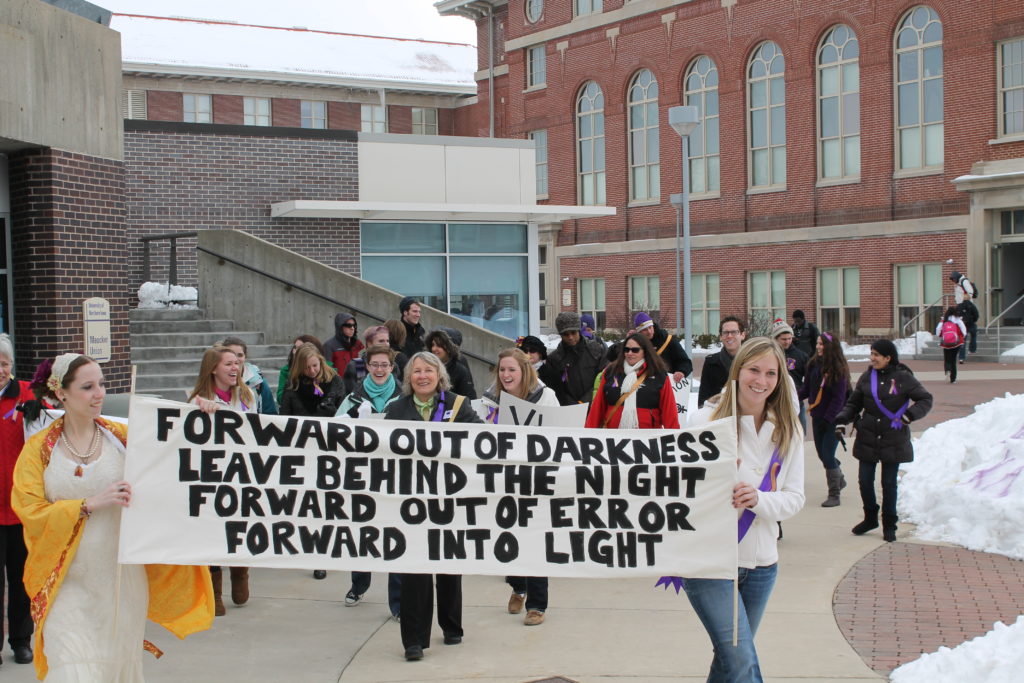Sophie Cappello contributed to this article.
As we celebrate Women’s Equality Day today—and openly recognize it’s flawed history in the full enfranchisement of all women—we continue the fight for equality and self-determination in our democracy. Next year, when we mark the centennial of (white) women’s suffrage in the U.S., the same rallying cry of the suffragists will remain our most powerful weapon.

The 2018 elections proved that “Votes for Women” has moved from granting women the right to vote to voting for women as candidates and incumbent elected officials. The groundbreaking midterms that year brought an extraordinary number of women into office, from remarkable takeovers at the state and local levels to a record-breaking number of Congressional wins.
The number of women who successfully ran in 2018 was so great that this election cycle was dubbed the “women’s wave” and a new kind of women’s political movement was born—more racially diverse, more outwardly feminist, proudly young and ambitious. In total, 86 statewide executives, including nine governors, 15 lieutenant governors and 62 other statewide executive offices are now held by women. Women also made history in the United States House of Representatives, winning over 100 seats for the first time ever—with young women of color leading the way. Approximately 2,118 women now serve in state legislatures across the country, meaning nearly 30 percent of the state legislature seats in all 50 states are filled by women. Perhaps the most notable moment of the women’s wave happened in Nevada, where women made history by making it the first state in America to have a majority-women legislature.
The record-breaking 2018 wins for women demonstrated significant progress in the women’s rights movement. They also proved that when women legislate, we all win.
Now that women have substantial representation in government, policy-making has changed for the better, particularly at the state level. Researchers have speculated about the impact that electing more women to state legislatures will have on policy for decades, if not a century. Historically, the numbers haven’t really been strong enough to see what that impact looks like on a national scale. Until now. In states where women greatly succeeded in 2018—namely Nevada, Colorado, Connecticut, Illinois, Maine and New York—the 2019 legislative season proved crucial in advancing economic equality, reproductive justice, climate action and common sense gun reform.
As this legislative season came to a close, Nevada Governor Steve Sisolak (D) signed a number of bills to address and combat economic inequalities across the state—many thanks to the work of State Senator Joyce Woodhouse (D) and Democratic leadership in both chambers, which, combined, are majority women.
Woodhouse sponsored SB312, which allows employees to earn up to 40 hours of paid leave per year if they work for an employer with more than 50 employees and promises to “ensure equal pay for equal work,” and Sisolak signed a bill that would raise the minimum wage to either $12 or $11 an hour, depending on whether one’s employer provides health insurance, by 2023. This marks the first time in 10 years that Nevada’s minimum wage will increase.
The success of women in 2018 Connecticut races also yielded steps toward economic equality. Some of the biggest General Assembly upsets of the 2018 midterms happened in the Constitution State; women running for office for the first time ousted Senate incumbents in three of the five races and women beat incumbents in five of the eleven House races.
“Women are going to take the lead and be at the forefront of the change we bring to Hartford,” said State Senator Julie Kushner in November. That they did, with economic issues at the top of the agenda. Senate President Martin Looney told The Hartford Courant in February that paid family leave was the number one priority this session; by June, Governor Ned Lamont and the Democratic leadership succeeded in passing a bill that introduced a paid family and medical leave program. Connecticut also raised minimum wage to $15 an hour this session, though the details on how to phase this in are still being negotiated.
Illinois will also see an increase in minimum wage to $15 an hour by 2025, in large part due to the indefatigable efforts of Senate Majority Leader Kimberly Lightfor (D) who sponsored this minimum wage bill, and multiple previous, unsuccessful ones, recently signed by Governor J.B. Pritzker (D).
Predictably but no less impressively, women across the country have stepped up to fight for reproductive freedom and justice. In the last few months, states like Ohio, Missouri and Georgia have passed versions of a “heartbeat bill,” which bans abortion at the moment a fetal heartbeat is detected — typically six weeks into the pregnancy. Alabama even passed a law that punishes doctors who perform abortions.
In these states—where women’s gains, if any, were overwhelmingly made in the state House and by Democratic women—it was male leadership that set the agenda for this assault on women’s rights. Either concurrently or in response to these controversial pieces of legislation, states that saw a critical mass of women elected to their legislatures or executive offices in 2018 passed laws to protect bodily autonomy and to make reproductive healthcare more accessible for all.
In November, Maine elected Democrat Janet Mills, its first female governor in state history. In response to the heartbeat bills, Mills was quick to expand access to abortion services. She made national news earlier this month when she signed a bill that authorizes two non-doctor categories of medical professionals to perform abortions, increasing accessibility particularly for those seeking abortions in rural areas. Maine will join New Hampshire, Vermont, California and Colorado in states where this is legal.
Nevada legislators passed Senate Bill 179, or the Trust Nevada Women Act, which removes several restrictions on abortion, including a requirement that doctors inform patients of the “emotional implications” of abortions and criminal penalties for those who induce abortion without advice from a doctor. Illinois State Representative Kelly Cassidy and state Senator Melinda Bush co-sponsored the most comprehensive bill to date, protecting an individual’s right to make their own decisions about their reproductive health and stating that a “fertilized egg, embryo or fetus does not have independent rights under the law of this state.” It was signed by Governor Pritzker earlier this month, who said it “ensures that women’s rights do not hinge on Roe v. Wade or the whims of an increasingly conservative Supreme Court in Washington.”
It may come as no surprise that issues regarding pay equity, paid family leave and reproductive freedom—items that are categorically considered “women’s issues”—saw an increase of attention in state legislatures with higher numbers of women. But another issue that women were quick to address this legislative session is arguably the most pressing global threat of our time, and it impacts all of us.
According to The Washington Post, polling shows that women are significantly more likely than men to label climate change as a “serious problem” that requires serious life-style changes to combat. So it’s no surprise that women are on the forefront of combating the impending threats of climate change.
Colorado’s state legislature ranks number two in the nation at 47 percent. Over half of Colorado’s state representatives are women, 13 of its thirty-five state Senators are women and seven of its eleven House committees are chaired by women. In this recent session, women worked to pass breakthrough legislation on paid family leave and education—and led the charge on an aggressive piece of legislation to tackle climate change. The four sponsors were all women.
The Green New Deal (GND), introduced to the House of Representatives by freshman Congresswoman Alexandra Ocasio-Cortez, sets ambitious goals for cutting carbon emissions while also creating jobs and boosting the economy. While the GND faces its own host of grid-lock-related challenges in the Capitol, states that saw an increase of women elected in 2018 have adopted components of it into their new policies to address climate change. Connecticut proposed House Bill 5002, or An Act Concerning the Development of a Green New Deal in February. Minnesota proposed a bill that would acquire all of the state’s electricity from non-carbon sources by 2030—the same deadline as the Green New Deal.
Women are springing into action with a sense of urgency that combating climate change needs—one that hasn’t been previously seen in policy. There is, quite literally, no time to waste here. Scientists warn that we have between twelve and twenty-five years to limit the catastrophic effects of climate change. Women across America are recognizing that, and women in offices across the country are acting on it.
While climate change may pose the most serious global and existential threat of our time, the United States is uniquely plagued by our domestic gun violence epidemic. This past weekend, two mass shootings occurred in El Paso, TX and Dayton, OH leaving at least 31 people dead across both cities and countless more wounded. This occurred less than one week after a shooter opened fire at a garlic festival in Gilroy, CA leaving three people dead—two of whom were children—after firing 39 rounds. In all three cases, along with the vast majority of mass shootings in America, the guns used were legally purchased and owned. These tragedies mark only the most recent examples of gun massacres in the United States, most of which have been inspired by white supremacy, rooted in misogyny and ripe with hateful rhetoric.
Gridlocked Congress has done virtually nothing to prevent this epidemic, but states that elected more women to their legislatures in 2018 have already seen common sense gun reform passed into law. In March, Illinois passed legislation to reduce illegal gun trafficking and hold gun dealers accountable, and the New York State Senate passed two pieces of legislation to strengthen gun regulation and prevent gun violence sponsored by State Senators Liz Krueger and Brad Hoylman. Together, the New York bills requires the safe storage of rifles, shotguns and firearms and clarifies the definition of an imitation weapon or toy gun, by making it consistent with New York City Administrative Code. Senate Majority Leader Andrea Stewart-Cousins praised her colleagues for their work to prevent gun violence and protect children from accessing dangerous weapons, saying, “These tragedies are preventable, and today we took an important step that will save lives and keep families whole.”
On June 5th, the majority-women Nevada state legislature passed SB143 into law which requires background checks on all gun sales. Also on June 5th, Nevada passed AB291 which requires people to safely store firearms and bans devices used to convert semiautomatic firearms into automatic guns, along with SB89 which requires evidence-based threat assessment programs in schools. On the opposite side of the country on that same day, Connecticut governor Ned Lamont signed three bills passed by the state legislature into law that strengthened the state’s current gun safety legislation: HB2718 requires firearm owners to keep their guns securely stored, HB2719 prohibits undetectable and untraceable firearms, and HB7223 requires owners of pistols and handguns to safely store these guns in a locked container if ever left in a vehicle. Later that month, Connecticut also increased funding for Project Longevity in its 2019 budget.
The fight for common sense gun reform happening on the ground is also being led by women, namely by the group Moms Demand Action which was founded by Shannon Watts in light of the 2012 Sandy Hook shooting. Moms Demand Action, in partnership with Everytown for Gun Safety, is a grassroots movement with over six million supporters fighting for public safety measures to protect people from gun violence. As they call for a #SenateVoteNow, they may find greater and faster recourse in electing more women to the United States Senate to combat the partisan inertia in our nation’s capital. The common sense gun reform passed in the first legislative session of 2019 in Illinois, Nevada, New York and Connecticut yet again demonstrates the efficiency of legislative change on the most pressing issues when more women are in office. (To learn more about how to help the victims of the recent El Paso and Dayton shootings, visit the Public Good campaign by clicking here).
The fight for votes for women was the first step in full enfranchisement of women in American democracy, and the first legislative session of 2019 may have been the first step for women’s equal—if not majority—representation in American government. Their leadership has brought ‘women’s issues’ to the forefront of policy, with conversations about abortion, pay equity and outright sexism being had in earnest, one the most ominous global crises of our time is being tackled head-on; and widespread gun violence, the biggest domestic threat we face as a nation, is being prevented. If we want to continue to celebrate women’s progress—and fulfill the promise of our democracy—“Votes for Women” must once again be our rallying cry.
The 2018 midterms demonstrated that when women run, we all win. This is something to celebrate today—and to repeat in 2020, on the 100th anniversary of the 19th Amendment.





